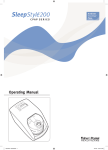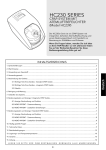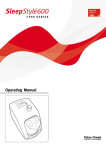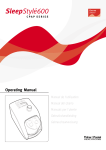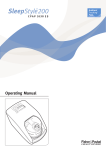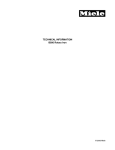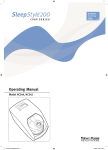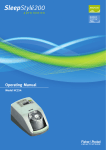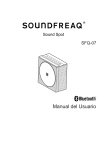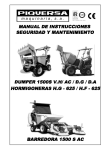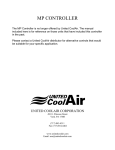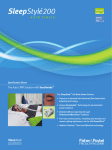Download Fisher & Paykel HC230 User's Manual
Transcript
S SERIE HC230 Operating Manual Manuel de l’utilisation Manual del Usiario SECTION English . . . . . . . . . . . . . . . . . . . . A Francais . . . . . . . . . . . . . . . . . . . B Español . . . . . . . . . . . . . . . . . . . C HUMIDIFIED CPAP SYSTEMS The HC230 series are a range of CPAP systems designed for use in the home for the treatment of OSA. For further assistance, please contact your local F&P office – see reverse for addresses. Please keep this manual for future reference. TABLE OF CONTENTS 1. Symbol Definitions . . . . . . . . . . . . . . . . . . . . . . . . . . . . . . . . . . . . . . . . . . . . . . . . . . . . . . . . . . . . . . . . . . . . . . . . . . . . . . . . 2 2. Warnings . . . . . . . . . . . . . . . . . . . . . . . . . . . . . . . . . . . . . . . . . . . . . . . . . . . . . . . . . . . . . . . . . . . . . . . . . . . . . . . . . . . . . . . 2 3. Oxygen Use Warnings . . . . . . . . . . . . . . . . . . . . . . . . . . . . . . . . . . . . . . . . . . . . . . . . . . . . . . . . . . . . . . . . . . . . . . . . . . . . . 2 4. Intended Use . . . . . . . . . . . . . . . . . . . . . . . . . . . . . . . . . . . . . . . . . . . . . . . . . . . . . . . . . . . . . . . . . . . . . . . . . . . . . . . . . . . . . 2 5. Description of the device . . . . . . . . . . . . . . . . . . . . . . . . . . . . . . . . . . . . . . . . . . . . . . . . . . . . . . . . . . . . . . . . . . . . . . . . . . . 3 5.1 Package Contents. . . . . . . . . . . . . . . . . . . . . . . . . . . . . . . . . . . . . . . . . . . . . . . . . . . . . . . . . . . . . . . . . . . . . . . . . . . . . . 3 5.2 Important Parts of Your Device . . . . . . . . . . . . . . . . . . . . . . . . . . . . . . . . . . . . . . . . . . . . . . . . . . . . . . . . . . . . . . . . . . . 3 5.3 Accessories . . . . . . . . . . . . . . . . . . . . . . . . . . . . . . . . . . . . . . . . . . . . . . . . . . . . . . . . . . . . . . . . . . . . . . . . . . . . . . . . . . 3 6. Cleaning & Maintenance . . . . . . . . . . . . . . . . . . . . . . . . . . . . . . . . . . . . . . . . . . . . . . . . . . . . . . . . . . . . . . . . . . . . . . . . . . . 4 7. Setup Instructions . . . . . . . . . . . . . . . . . . . . . . . . . . . . . . . . . . . . . . . . . . . . . . . . . . . . . . . . . . . . . . . . . . . . . . . . . . . . . . . . 4 8. Controls and Display . . . . . . . . . . . . . . . . . . . . . . . . . . . . . . . . . . . . . . . . . . . . . . . . . . . . . . . . . . . . . . . . . . . . . . . . . . . . . . 5 8.1 Display Descriptions and Functions . . . . . . . . . . . . . . . . . . . . . . . . . . . . . . . . . . . . . . . . . . . . . . . . . . . . . . . . . . . . . . . . 5 8.2 Patient Menu Summary . . . . . . . . . . . . . . . . . . . . . . . . . . . . . . . . . . . . . . . . . . . . . . . . . . . . . . . . . . . . . . . . . . . . . . . . . 6 8.3 Patient Menu - Additional Settings Summary . . . . . . . . . . . . . . . . . . . . . . . . . . . . . . . . . . . . . . . . . . . . . . . . . . . . . . . . . 6 9. Frequently Asked Questions . . . . . . . . . . . . . . . . . . . . . . . . . . . . . . . . . . . . . . . . . . . . . . . . . . . . . . . . . . . . . . . . . . . . . . . . . 7 10. Product Specifications . . . . . . . . . . . . . . . . . . . . . . . . . . . . . . . . . . . . . . . . . . . . . . . . . . . . . . . . . . . . . . . . . . . . . . . . . . . . . 7 11. Operating conditions . . . . . . . . . . . . . . . . . . . . . . . . . . . . . . . . . . . . . . . . . . . . . . . . . . . . . . . . . . . . . . . . . . . . . . . . . . . . . 8 12. Storage and Transport conditions . . . . . . . . . . . . . . . . . . . . . . . . . . . . . . . . . . . . . . . . . . . . . . . . . . . . . . . . . . . . . . . . . . . . 8 13. Troubleshooting . . . . . . . . . . . . . . . . . . . . . . . . . . . . . . . . . . . . . . . . . . . . . . . . . . . . . . . . . . . . . . . . . . . . . . . . . . . . . . . . . 8 PLEASE READ ALL INSTRUCTIONS BEFORE INITIAL USE C a u t i o n : U S A F e d e r a l L a w re s t r i c t s t h i s d e v i c e f o r s a l e b y o r o n t h e o rd e r o f a p h y s i c i a n . A-1 English HC230 SERIES 1. SYMBOL DEFINITIONS Type BF Applied Part ATTENTION Consult accompanying documents Drip Proof Alternating Current Class ll Double Insulated Standby or On/Off 93/42/EEC Class IIb 2. WARNINGS 1. 2. 3. 4. 5. 6. 7. 8. 9. PLEASE NOTE:- This manual refers to the HC230 Series CPAP unit as "the device". The device should only be used with masks, connectors and delivery tubes recommended by Fisher & Paykel Healthcare, or by your physician or respiratory therapist. Never operate the device if: a) it has a damaged power cord or plug, b) the tube has been damaged with holes, tears or kinks, c) it has been dropped or damaged, d) it has been dropped into water, e) it is not working properly. Return the device to an authorised service center for examination and repair. Do not use the device when the room temperature exceeds 35°C (95°F) as this may lead to an elevated airflow temperature which may give rise to an irritation of the airways. Ensure an air filter is fitted when operating your unit. Remove the humidification chamber before filling. Do not fill the chamber with boiling water. When handling the device with chamber and water avoid tilting the machine to prevent any chance of water entering the unit enclosure. Place your device on a level surface lower than your head height to prevent water entering the respiratory tubing should the device be knocked over. Do not store or use your device where it can fall or be pulled into water. If water has entered the unit enclosure, disconnect the power cord and discontinue use. Seek advice from your homecare provider. 10. Never block the air openings of the device or place it on a soft surface such as a bed or couch, where the filter area may be blocked. Keep the air openings free of lint, hair or the like. 11. Ensure that the unit is dry before plugging into the power socket. 12. A mask should not be used unless the device is switched on, and operating properly. The vent hole(s) associated with the mask should never be blocked. 13. Due to the operating temperature of the heater plate, avoid making contact to the exposed heater plate or chamber base. 14. At low CPAP pressures, the flow through the mask may be insufficient to clear all exhaled gas from the tubing, and consequently some re-breathing may occur. 15. Adjusting the pressure control can result in ineffective therapy. The pressure control must only be adjusted by a healthcare professional. 16. Never drop or insert any object into any opening or tube. 17. Always switch off the device and unplug the power cord from the power socket before cleaning. 18. Empty all the water from the chamber before transporting your device. 19. Refer all maintenance to qualified service personnel except as outlined in this manual. 3. OXYGEN USE WARNINGS If supplemental oxygen is used with the device, the oxygen flow must be turned off when the device is not operating. This ensures that oxygen will not flow through the tube and accumulate in the device enclosure. • • • • The device should be located in a position where ventilation around the device is not restricted. • A spontaneous and violent ignition may occur if oil, grease or greasy substances come in contact with oxygen under pressure. These substances must be kept away from oxygen regulators, cylinder valves, tubing and connections, and all other oxygen equipment. • At a fixed flow rate of supplemental oxygen flow, the inhaled oxygen concentration will vary, depending on the pressure settings, patient breathing pattern, mask selection and leak rate. It is recommended that supplemental oxygen be administered at the mask. Oxygen should not be used while smoking or in the presence of an open flame. The use of oxygen in therapy requires that special care be taken to reduce the risk of fire. Any materials which will burn in air and some that will not are easily ignited and burn rapidly in high concentrations of oxygen. Accordingly, for safety it is necessary that all sources of ignition be kept away from the product and preferably out of the room in which it is being used. 4. INTENDED USE The device is used to assist with patient breathing while sleeping, for the purpose of treating Obstructive Sleep Apnea (OSA). This is done by the delivery of Continuous Positive Airway Pressure (CPAP) in order to prevent airway obstruction. The addition of heated respiratory humidification to the device relieves the drying and irritating effects on the patient airways which usually arises from use of a CPAP system. The CPAP device is for use on adult patients at home or in the sleep lab. A-2 5. DESCRIPTION OF THE DEVICE English 5.1 Package Contents 1 x tube 2 x Water Chamber 1 x Power Cord 1 x Spare Air Filter 1 x Funnel Accessories 1 x HC230 series 5.2 Important Parts of Your Device POWER CORD ON/OFF BUTTON HEATERPLATE 900HC221 TUBE FILTER HOLDER AIR FILTER DISPLAY 900HC010 CONNECTOR CHAMBER GUARD WATER CHAMBER WATER LEVEL LINE 5.3 Accessories HC385 Water Chamber – disposable 900HC230 Compliance Maximizer Software HC355* Water Chamber – reusable 900HC232 Compliance Download Serial Cable 900HC010 Connector HC225 Remote Control (Laboratory) 900HC221 Tube 900HC226 Lead Extension Kit for HC225 900HC240 Filter *Not available in all countries A-3 6. CLEANING & MAINTENANCE 1. Switch off the device and unplug from the power socket. 2. Wipe the exterior of the device with a clean, damp (not wet) cloth and mild dishwashing detergent. Do not use harsh abrasives or solvents, or these may damage the device. 3. DAILY Clean chamber and tube. Remove the breathing tube from the chamber. Rinse the tube with soapy water. Hang – up hose with hose ends pointing to floor to dry. Remove the chamber by pushing down the finger guard and pulling out the chamber. Pour out & discard the remaining water. Clean the chamber with soapy water, rinse and dry. • • • • • 4. WEEKLY Thoroughly clean the chamber Soak the inside of the chamber for 10 minutes in a solution of one part white vinegar to five parts water. • 5. Replace the air filter when it becomes significantly discoloured, at least once every 3 months or after 1000 hours machine running time. Remove the filter holder from the back of the device and take out the filter. Replace the old filter with a new filter: Ensure the vertical black line is facing towards the device. • • 7. SETUP INSTRUCTIONS HOW TO SET UP YOUR SYSTEM 1. Remove your device from its packaging. 2. Place the device on a low shelf or on the floor beside your bed, the unit needs to be placed below head height. 3. Remove one water chamber from the packaging. 4. Remove the blue caps and discard them (Fig.1). 5. Fill the chamber up to the water filling line with distilled water only (Fig.2). Fig.1 Fig.2 Fig.3 Fig.4 Never fill the chamber while it is attached to the device. When moving your device, ensure that the water chamber is empty. Machine failure due to water damage is not covered by warranty. 6. To attach the water chamber to the device, press down the finger guard and slide the chamber on (Fig.3) (Fig. 4). 7. When the chamber is fitted correctly, the finger guard will click into place. 8. One end of the tube has a white plastic connector. Push this onto the outlet on top of the chamber. (Fig.5) 9. Connect the other end of the tube to the mask. 10. Plug the device power cord into your household power socket and rear of device. 11. Fig.5 Switch on the device by pressing the on/off button (See Fig.6 ). The current humidity setting is displayed. 12. For changing the setting refer to section 8 “Controls and Display”. Your device is now ready for use. A-4 Fig.6 DISPLAY AND FUNCTIONS English 8.1 DISPLAY DESCRIPTION On/Off Button Ramp button Up button Increase Setting Down button Decrease Setting Mode button Step through the options KEY FUNCTION & DESCRIPTION ON/OFF Switches the device ON & OFF OPERATION TO SWITCH “ON” Press button down briefly The device will default to display the humidity setting. TO SWITCH “OFF” Remove your mask Press button down briefly RAMP Reduces pressure to a lower level to help you fall asleep. The pressure will gradually return to full operating pressure over 20 minutes TO SWITCH “OFF” Press the ON/OFF button INCREASE/DECREASE Adjusts settings up or down Press the MODE To step through options Press sequentially to step through and view options available and button to raise or lower settings OPERATION < TO VIEW ITEMS Press the “ ” key to sequentially view: Humidity setting (default display) For adjusting humidity levels to minimize upper airway side effects from CPAP use Press the and button to raise or lower settings < PATIENT MENU DISPLAY For viewing of CPAP settings, humidity, compliance data, altitude and pressure settings < < < TO SWITCH “ON” Press the RAMP button NB: to reset ramp during a cycle the device must be switched off first < hr Total run hours* Displays the total number of hours the device has been switched on (includes hours without mask use) hr/ Average compliance hours per night* Displays average number of hours the device has been used at night with the mask on Checksum* Displays information for medical practitioner or dealer use to check compliance Altitude setting Displays altitude setting cmH2O PATIENT MENU - ADDITIONAL SETTINGS DISPLAY To access additional settings: OPERATION Altitude Select “m” for metres of “ft” for feet using the and keys < From the Default setting “HUMIDITY” Press the “ Pressure setting Displays pressure setting ” key for 3 seconds 3000 < Altitude level - Press to change altitude level - Set the altitude level by pressing the - Press to exit menu and keys < AND < 8. CONTROLS Warning: Failure to select correct altitude setting (for any given location) will have an adverse effect on set pressure delivery. * only available on devices with compliance monitoring. A-5 8.2 PATIENT MENU SUMMARY Press once to switch device on/off Press to activate Ramp Increase Decrease Display MODE Humidity Setting (default) Average Hours per night hr/ Total Run Time hr Altitude Setting Check sum cmH2O RETURN TO DEFAULT < < or Pressure Setting 0,1,2,3,4 + 0.5 INCREMENT - 8.3 PATIENT MENU - ADDITIONAL SETTINGS SUMMARY Press once to switch device on/off Press to activate Ramp Increase Decrease Display MODE ADVANCED PATIENT MENU ft or RETURN TO DEFAULT 3000 m Hold for 3 seconds or < < Select Units for Altitude < < or Increase/Decrease altitude Level Warning: Failure to select correct altitude setting (for any given location) will have an adverse effect on set pressure delivery. A-6 When I wake up in the morning, my nose and throat feel dry. What can I do? Try increasing your humidity setting. If this does not help, please contact your clinician for advice. How do I prevent condensation in the tubing? The humidity setting enables adjustment of humidity, so that there should be fine misting in the six inches (183cm) of the breathing tube closest to your face. If the humidity setting is too high for the conditions, condensation may occur in the breathing tube. Note: Using greater than 6' (183 cm) of tubing will increase condensation. There are several ways of reducing condensation in the tube: 1. Ensure the device is not positioned in a cool draft. 2. Decrease the humidity setting on your device slightly. Gradually decrease the setting until the condensation no longer occurs. 3. Warm the air in the room. Do I have to use distilled water with my device? The use of distilled water will maximize the life of the water chamber. Water from the faucet will often contain minerals which can damage the chamber, causing pitting in the base, even if the water is passed through a filter. Can I use my device in other countries? Yes. Simply use the appropriate electrical socket adaptor and the device will automatically adapt to any voltage supply. Note: When moving your device, ensure that the water chamber is empty. Machine failure due to water damage is not covered by warranty. Can I use supplemental oxygen with my device? Yes, oxygen can be administered at the mask. Turn the device on before turning on the oxygen. Ensure that the oxygen source is turned off before turning off the device to avoid oxygen accumulating in the machine. When do I replace my water chamber? Replace the chamber if the plastic walls of the chamber become cracked or cloudy or the chamber base becomes pitted. (Note: If the chamber leaks at all, it should be replaced immediately). 10. SPECIFICATIONS DIMENSIONS: 275mm x 170mm x 140mm WEIGHT: 1.9kg (3.0kg packaged in bag incl. accessories) STANDARDS COMPLIANCE Designed to conform to the requirements of: ELECTRICAL RATINGS Supply Frequency: Supply Voltage and Current: 50-60 Hz 100-115V~ (1.2A, 1.3A max), 220-240V~ (0.8A, 1.8A max) Note: These values represent average current DC to AC Inverter requirements: 115V - 200W/300W surge 230V - 300W/500W surge Heater Plate : Heater Plate Temperature: 85W max 65°C (149°F) max PERFORMANCE Pressure Range Altitude Range 4 to 20 cmH2O 0 to 3000m, or 0 to 9000 ft EN / IEC 60601-1 UL2601-1 CSA C22.2/No.60601.1 AS3200.1.0 The device complies with the electromagnetic compatibility requirements of IEC 60601-1-2. In certain circumstances, the device may affect or be affected by nearby equipment due to the effects of electromagnetic interference. If this should happen, try moving your unit or the location of the device causing interference, or alternatively consult your homecare provider. A -7 English 9. FREQUENTLY ASKED QUESTIONS 11. OPERATING CONDITIONS: AMBIENT TEMPERATURE: 5° - 35°C HUMIDITY: 10 - 95% RH ALTITUDE: 0 - 3000m (9000ft) Above 500m (1500 ft) the maximum operating pressure will be reduced. 12. STORAGE AND TRANSPORT CONDITIONS: The device should be stored and transported in environmental conditions of: -10° to 60°C . 13. TROUBLESHOOTING: If you feel that your device is not operating correctly, consult your homecare dealer. Do not attempt to repair the device yourself. Fisher & Paykel Healthcare have a policy of continued product improvement and reserve the right to alter specifications without notice. A- 8 HC230 SERIES PPC AVEC SYSTÈME D’HUMIDIFICATION INTÉGRÉ Pour une assistance complémentaire, veuillez contacter votre Bureau local F&P – voir adresse au verso. Conserver ce manuel pour futures références. TABLE DES MATIÈRES 1. Définitions des symboles . . . . . . . . . . . . . . . . . . . . . . . . . . . . . . . . . . . . . . . . . . . . . . . . . . . . . . . . . . . . . . . . . . . . . . . . . . . 2 2. Avertissement . . . . . . . . . . . . . . . . . . . . . . . . . . . . . . . . . . . . . . . . . . . . . . . . . . . . . . . . . . . . . . . . . . . . . . . . . . . . . . . . . . . . 2 3. Avertissement contre l’utilisation d’oxygène . . . . . . . . . . . . . . . . . . . . . . . . . . . . . . . . . . . . . . . . . . . . . . . . . . . . . . . . . . . . . 2 4. Utilisation recommandée . . . . . . . . . . . . . . . . . . . . . . . . . . . . . . . . . . . . . . . . . . . . . . . . . . . . . . . . . . . . . . . . . . . . . . . . . . . . 2 5. Description de l’appareil . . . . . . . . . . . . . . . . . . . . . . . . . . . . . . . . . . . . . . . . . . . . . . . . . . . . . . . . . . . . . . . . . . . . . . . . . . . 3 5.1 Contenu de l’emballage . . . . . . . . . . . . . . . . . . . . . . . . . . . . . . . . . . . . . . . . . . . . . . . . . . . . . . . . . . . . . . . . . . . . . . . . . 3 5.2 Eléments importants de l’appareil ................................................................3 5.3 Accessoires . . . . . . . . . . . . . . . . . . . . . . . . . . . . . . . . . . . . . . . . . . . . . . . . . . . . . . . . . . . . . . . . . . . . . . . . . . . . . . . . . . 3 6. Nettoyage et Entretien . . . . . . . . . . . . . . . . . . . . . . . . . . . . . . . . . . . . . . . . . . . . . . . . . . . . . . . . . . . . . . . . . . . . . . . . . . . . . 4 7. Instructions d’installation . . . . . . . . . . . . . . . . . . . . . . . . . . . . . . . . . . . . . . . . . . . . . . . . . . . . . . . . . . . . . . . . . . . . . . . . . . . 4 8. Contrôles et Affichages . . . . . . . . . . . . . . . . . . . . . . . . . . . . . . . . . . . . . . . . . . . . . . . . . . . . . . . . . . . . . . . . . . . . . . . . . . . . 5 8.1 Affichages: Description et Fonction . . . . . . . . . . . . . . . . . . . . . . . . . . . . . . . . . . . . . . . . . . . . . . . . . . . . . . . . . . . . . . . . 5 8.2 Sommaire Menu Patient . . . . . . . . . . . . . . . . . . . . . . . . . . . . . . . . . . . . . . . . . . . . . . . . . . . . . . . . . . . . . . . . . . . . . . . . 6 8.3 Sommaire Menu Patient: Réglages Supplémentaires . . . . . . . . . . . . . . . . . . . . . . . . . . . . . . . . . . . . . . . . . . . . . . . . . . . 6 9. Questions fréquemment posées . . . . . . . . . . . . . . . . . . . . . . . . . . . . . . . . . . . . . . . . . . . . . . . . . . . . . . . . . . . . . . . . . . . . . . 7 10. Caractéristiques techniques. . . . . . . . . . . . . . . . . . . . . . . . . . . . . . . . . . . . . . . . . . . . . . . . . . . . . . . . . . . . . . . . . . . . . . . . . 7 11. Conditions de fonctionnement . . . . . . . . . . . . . . . . . . . . . . . . . . . . . . . . . . . . . . . . . . . . . . . . . . . . . . . . . . . . . . . . . . . . . . 8 12. Entreposage et transport. . . . . . . . . . . . . . . . . . . . . . . . . . . . . . . . . . . . . . . . . . . . . . . . . . . . . . . . . . . . . . . . . . . . . . . . . . . 8 13. Dépannage . . . . . . . . . . . . . . . . . . . . . . . . . . . . . . . . . . . . . . . . . . . . . . . . . . . . . . . . . . . . . . . . . . . . . . . . . . . . . . . . . . . . . 8 VEUILLEZ LIRE LES INSTRUCTIONS DANS LEUR TOTALITE AVANT D’UTILISER VOTRE APPAREIL POUR LA PREMIERE FOIS B-1 Français Les systèmes de PPC de série HC230 ont été conçus pour le traitement à domicile du SAS. 1. DÉFINITION Type BF Pièce utilisée DES SYMBOLES ATTENTION Consulter les documents joints Anti-écoulement Courant alternatif Class ll Double isolation Veille On/Off 93/42/EEC Classe IIb 2. AVERTISSEMENT 1. 2. 3. 4. 5. 6. 7. 8. 9. A noter: ce mode d'emploi se réfère à l'appareil de PPC HC230 comme l'appareil L’appareil ne peut être utilisé qu’avec des masques, connecteurs et circuit recommandés par Fisher & Paykel Healthcare, votre médecin ou thérapeute. Ne jamais utiliser l’appareil si: a) son cordon d’alimentation ou sa prise est endommagé, b) Le circuit est endommagé : trous, déchirures, pliures, c) l’appareil est endommagé ou s’il est tombé par terre, d) l’appareil est tombé dans l’eau, e) l’appareil ne fonctionne pas correctement. Retourner l’appareil à un centre de dépannage agrée pour inspection et réparation. Ne pas utiliser l’appareil lorsque la température extérieure s’élève à plus de 35°C (95°F), cela pouvant accroître la température du flux d’air, risquant d’entraîner une irritation des voies respiratoires. S’assurer que le filtre à air est présent lorsque vous vous servez de l’appareil. Retirer la chambre d’humification avant remplissage. Ne pas remplir la chambre avec de l’eau bouillante When handling the device with a chamber and water avoid tilting the machine to prevent any chance of water entering the unit enclosure. Placer votre appareil à une hauteur inférieure à celle de votre tête pour éviter tout risque de pénétration d’eau dans le circuit chauffant au cas où l’appareil serait renversé. Ne pas entreposer ou utiliser l'appareil dans un endroit où il est susceptible de tomber par terre ou dans l’eau. Si de 3. AVERTISSEMENT l’eau s’est infiltrée dans l’appareil, déconnecter le cordon d’alimentation et ne plus l’utiliser. Solliciter le conseil de votre prestataire de service. 10. Ne jamais boucher les ouvertures d’air du l'appareil ou le placer sur une surface tel un lit ou un canapé, sur lesquels le filtre risque de s’obstruer. S’assurer que les ouvertures d’air ne comportent pas de matières telles que des peluches ou cheveux. 11. S’assurer que l’appareil est sec avant de le rebrancher. 12. Ne pas utiliser de masque si l’appareil est éteint ou s’il ne fonctionne pas correctement. Ne jamais boucher la fuite expiratoire du masque. 13. En raison de la température de fonctionnement de la plaque chauffante, éviter tous contacts avec la plaque chauffante ou la base de la chambre d’humidification. 14. Si la pression PPC est basse, le flux circulant à travers le masque peut s’avérer insuffisant pour évacuer tous les gaz exhalés du circuit chauffant, ce qui peut entraîner une reinhalation. 15. Changer la pression peut rendre la thérapie inefficace. La pression ne devrait être contrôlée que par un professionnel du corps médical. 16. Ne jamais insérer ou faire tomber de corps étrangers dans les ouvertures ou le tuyau. 17. Avant tout nettoyage, éteindre l’appareil et débrancher le cordon d’alimentation de la prise murale. 18. Vider la totalité de l’eau avant transport. 19. Tout entretien autre que celui décrit dans ce manuel doit être effectué par du personnel qualifié. CONTRE L’UTILISATION D’OXYGÈNE Si une quantité supérieure d’oxygène est utilisée avec l’appareil, couper le débit d’oxygène lorsque l’appareil n’est pas en service. Cela empêche l’oxygène de passer par le tube et de s’accumuler à l’intérieur de l’appareil. • • • • • Le modè l’appareil doit être placé dans un endroit ventilé. Une adjonction d’oxygène doit être administrée au niveau du masque. L’oxygène ne doit pas être utilisée en présence de fumée de cigarette ou à proximité d’une flamme. La thérapie par oxygène comporte des risques d’incendie et requiert par conséquent une attention particulière. Tout matériau inflammable à l’air et certains matériaux non inflammables peuvent s’enflammer facilement en présence de hautes concentrations d’oxygène. C’est pourquoi, pour des raisons de sécurité, il est recommandé de garder à distance et de préférence hors de la pièce où l’appareil est utilisé toute source possible d’ignition. Une inflammation spontanée et agressive peut se produire si de l’huile, de la graisse ou des substances graisseuses, entrent en contact avec des régulateurs d’oxygène, soupapes, tubes et connecteurs, et tout autre équipement se rapportant à l’oxygène. A un taux fixe de débit d’oxygène, la concentration d’oxygène inhalée varie en fonction des paramètres de pression, le type d’inhalation, le masque et le taux de fuite. 4. UTILISATION RECOMMANDÉE L’appareil a pour objectif le traitement du syndrome des apnées du sommeil (SAS) et est particulièrement recommandé comme aide respiratoire de patients endormis. La méthode consiste à délivrer une Pression Positive Continue (PPC) afin de prévenir l’obstruction des voies respiratoires. L’adjonction d’un humidificateur respiratoire chauffant prévient les effets desséchants et irritants des voies respiratoires couramment observés lors de l’utilisation d’appareils PPC. L'appareil convient à domicile ainsi qu’une utilisation professionnelle dans les laboratoires du sommeil. B-2 5. DESCRIPTION DE L’APPAREIL 5.1 Contenu de l’emballage 1 x Cordon d’alimentation 1 x Circuit 1 x Filtre à air additionnel 1 x Entonnoir Accessoires 1 x humidificateur avec PPC Série HC230 5.2 Eléments importants de l’appareil CORDON D’ALIMENTATION INTERRUPTEUR PLAQUE CHAUFFANTE SUPPORT DE FILTRE CIRCUIT 900HC221 FILTRE A AIR AFFICHAGE CONNECTEUR 900HC010 DISPOSITIF PROTECTEUR DE LA CHAMBRE CHAMBRE D’HUMIDIFCATION HC385 NIVEAU D’EAU 5.3 Accessoires HC385 Chambre d’humidification jetable 900HC230 Logiciel d’observance Maximizer HC355* Chambre d’humidification réutilisable 900HC232 Câble série de téléchargement 900HC010 Connecteur HC225 Télécommande 900HC221 Circuit 900HC226 Rallonge d’extension du HC225 900HC240 Filtre à poussières (2-Pack) *Non disponible dans certains pays B-3 Français 2 x Chambre d'humidification 6. NETTOYAGE & ENTRETIEN 1. 2. 3. 4. Eteindre l’appareil et débrancher le cordon d’alimentation de la prise murale. Essuyer l’extérieur du l’appareil à l’aide d’un chiffon propre humecté d’eau (pas mouillé) et d’un détergent doux. Ne pas utiliser de produits abrasifs ou solvants risquant d’endommager l’appareil. JOURNALIER Nettoyer la chambre et le circuit. Déconnecter le circuit respiratoire de la chambre d’humidification. Rinser le circuit avec dle l’eau savonneuse. Pendre le circuit à la verticale pour qu’il sèche. Retirer la chambre en poussant la protection vers le bas et faire sortir la chambre. Vider et jeter l’eau usagée Nettoyer la chambre à l’eau savonneuse, rincer et laisser sécher HEBDOMADAIRE Nettoyer la chambre Nettoyer soigneusement la chambre en la faisant tremper 10 minutes dans une solution de vinaigre blanc et d’eau (1 dose de vinaigre blanc pour cinq doses d’eau). Replacer le filtre à air lorsqu’il se décolore de manière significative, au moins une fois tous les 3 mois ou après 1000 heures de fonctionnement. Retirer le support du filtre à l’arrière de l’appareil et retirer le filtre. Remplacer l’ancien filtre par un filtre neuf. La ligne verticale noire doit faire face à l’appareil. • • • • • • 5. • • 7. INSTRUCTIONS D’INSTALLATION 1. Retirer l’appareil de son emballage. 2. Placer l’appareil sur une étagère basse ou par terre à côté de votre lit. Placer l’appareil à une hauteur inférieure à celle de votre tête. 3. Retirer une chambre d'humidification de l’emballage. 4. Retirer et jeter les capuchons bleus (Fig.1). 5. Remplir la chambre d’humidification jusqu’au trait noir avec de l’eau.(Fig. 2) Ne jamais remplir la chambre d’humidification lorsqu’elle est en Fig.1 Fig.2 Fig.3 Fig.4 Fig.5 Fig.6 place. Lors du transport du l’appareil, toujours s’assurer que la chambre est vide. La garantie ne couvre pas les dommages occasionnés par l’eau. 6. Pour attacher la chambre d'humidification au l’appareil, appuyer sur la protection et y glisser la chambre. (Fig.3) (Fig. 4). 7. Lorsque la chambre est placée correctement, la protection s’enclenche 8. Une des extrémités du circuit possède un connecteur en plastique. Connecter cette extrémité à la sortie de la chambre d’humidification (Fig. 5). 9. Connecter l’autre extrémité au masque. 10. Brancher l’appareil à la prise murale. 11. Allumer l’appareil à l’aide de l’interrupteur se trouvant sur le dessus 12. Pour modifier les paramètres, consulter le chapitre “Contrôles et de l’appareil. (Fig.6) Affichages “ Votre appareil est prêt à être utilisé. B-4 AFFICHAGE 8.1 AFFICHAGES: DESCRIPTION FONCTION ET Interrupteur ON/OFF Bouton monté en pression progressive Bouton Haut Augmente le réglage Bouton Bas Bouton mode Naviguer entre les options BOUTON DESCRIPTION ET FONCTION FONCTIONNEMENT MARCHE /ARRET Mise en marche & arrêt METTRE EN MARCHE Appuyer sur le bouton brièvement. L’appareil affiche la valeur d’humidité par défaut . ETEINDRE L’APPAREIL Retirer le masque Appuyer sur le bouton brièvement MODE PROGRESSIF Réduction de pression pour favoriser l’endormissement. Augmentation progressive de la pression à la valeur prescrite après 20 minutes. AUGMENTER / DIMINUER Ajuste le réglage Utiliser le bouton MODE Naviguer entre les options Press sequentially to step through and view options available MENU PATIENT < < < METTRE EN MARCHE Appuyer sur le bouton du mode progressif A noter : pour réinitialiser le mode progressif lors d’un cycle, il est nécessaire d’éteindre l’appareil préalablement. ETEINDRE Appuyer sur le bouton Marche/Arrêt. et AFFICHAGE Visualisation des paramètres PPC (humidité, observance, données, altitude et pression) pour augmenter ou réduire les réglages FONCTIONNEMENT VISUALISER LES VALEURS hr hr/ < < Appuyer sur le bouton “ ” pour visualiser séquentiellement: Paramètres d’humidité (paramètres par défaut) Pour ajuster le niveau d’humidité a
This document in other languages
- français: Fisher & Paykel HC230



























